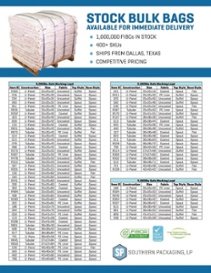How are Coronavirus and COVID-19 affecting the FIBC industry?
For over a year, the global pandemic has disrupted our daily lives and affected manufacturers’ supply chains to a degree, never before seen. This has..
November 17, 2020
A Flexible Intermediate Bulk Container or “FIBC” is manufactured using heavy gauge woven polypropylene (PP) fabric. The flexible fabric is created by weaving thick high-strength PP tapes. The tightly woven tapes form heavy sheets that are sewn together to form the bag. Once the fabric is woven, a layer of PP film can be laminated to the fabric to form a “coating”.
The basic process for manufacturing bag fabric is as follows:
Proper FIBC fabric weight is critical to the performance and safety of the FIBC. Insufficient fabric weight can lead to bag failures, injuries, and catastrophic accidents.
Fabric weight varies based on the bag’s application and the customer’s requirements. Tape thickness can be adjusted up or down to increase or decrease the fabric’s weight (i.e. thickness). In general, heavier woven fabric yields a bulk bag that can support higher safe working loads. For example, 160gsm fabric is suitable for a 2,000lbs SWL bag, whereas 245gsm fabric is suitable for a 4,000lbs SWL bag. For bags that are coated, the lamination layer typically weighs 30gsm. However, the lamination layer does not provide additional strength.
To weigh bulk bag fabric you will need a Fabric Sample Cutter and a high precision digital scale. First, cut a small square from the bulk bag body in 2 or more places. For tubular bags, cut sections from the body and below the lift loops.
Note that the non-load bearing components (e.g. fill spout, duffle, discharge spout) of the bag may be made from lighter fabric. This is a standard manufacturing practice.
.jpg?width=512&height=261&name=unnamed%20(14).jpg)
Next, use the fabric sample cutter to cut a circle out of the square sample.
%20(1).png?width=210&height=128&name=unnamed%20(6)%20(1).png)
Last, place the sample circle on the digital scale. The sample below is measured in grams. Multiply the sample by 100 to get the fabric weight per square meter.
You can convert grams per square meter to ounces per square yard if needed using the chart provided below.
.png?width=504&name=unnamed%20(7).png)
.png?width=512&name=unnamed%20(8).png)
We often see disparities between a bag’s written specification and the actual bag supplied. In an effort to reduce cost, suppliers may attempt to reduce the weight, strength, and size of multiple components of a bag. The supplier’s out-of-spec bag might perform as needed. However, this is a significant financial and operational risk that may not be worth taking.
ALWAYS compare your written specification to the actual bag being produced and confirm the bag is manufactured to your spec.
Fabric weight is the largest cost component in a bulk bag. Therefore, the easiest way to cut cost is to trim fabric weight. Suppliers may attempt to manufacture a bag with the lowest functional fabric weight to create the appearance of an ultra low-cost bag. What the supplier doesn’t realize is there may be other reasons why the customer’s bag is overbuilt. Maybe the bag undergoes significant stress and abuse during transit? Maybe the customer’s experience has lead them to increase the fabric weight over time?
The CUSTOMER should ALWAYS dictate the bag’s fabric weight to the supplier.
 About Southern Packaging
About Southern PackagingSouthern Packaging, LP stocks over 1,000,000 bulk bags available in hundreds of sizes and styles. Our dedicated sales team can help recommend different sizes and fabrics based on your ideal applications. Contact us today for more information or view our in-stock bulk bag list!